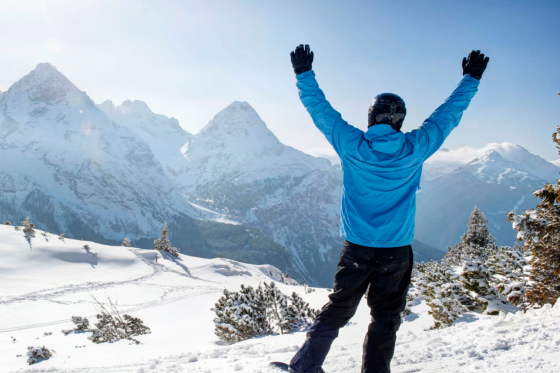As the Christmas season blankets our landscapes with its festive cheer and sparkling snow, the mountains call to us—the skiers, the boarders, the winter adventurers.
There’s a unique magic in carving through fresh powder, the cool air against your face, the world a blur of white and adrenaline.
Yet, with every swoop and every turn, there’s an unspoken understanding that the joy of snow sports comes with a risk: the risk of injury.
And nothing dampens the holiday spirit quite like the prospect of being confined to the couch, a spectator to the season’s joy rather than a participant.
In this blog you will uncover what causes snow sport injuries, and 5 proven tips to prevent them.
Ready, set, go…
Understanding Snow Sport Injuries
Snow sports injuries can range from mild twists and sprains to more serious fractures or ligament tears.
They’re often the result of falls, collisions, or improper technique, and the consequences can be far-reaching.
A moment’s miscalculation can lead to weeks, even months, of recovery.
The common thread among these injuries? Most are preventable with the right preparation.
The impact of these injuries extends beyond physical pain; it can mean missed opportunities for creating memories on family ski trips, or solitude when you should be celebrating with loved ones.
It’s not just about physical readiness; it’s about safeguarding the experiences that make the holiday season truly enchanting.
5 Proven Tips To Prepare For Snow Sports You Need To Hear
Begin with Balance: Mastering the Mountain
Balance isn’t just about not falling over—it’s about mastering your movements and responding with agility to the mountain’s call.
When you incorporate balance exercises into your pre-season training, you’re not just preparing to stand on one leg; you’re gearing up to navigate the unpredictable nature of snowy terrains.
Utilize a balance board to mimic the shifting slopes, or practice yoga to refine your proprioception.
Each balance exercise brings you closer to moving with the mountain rather than against it, ensuring each twist, turn, and jump is executed with poise and precision.
Core Strength is Key: Your Center of Power
Your core is the powerhouse of your body, the commander-in-chief of your snow sports endeavors.
When you strengthen this central unit with exercises like planks, Russian twists, and bridges, you’re doing more than toning muscles; you’re building a fortress against the forces that threaten to unbalance you.
This isn’t just about having a strong center; it’s about creating a foundation that allows the rest of your body to perform harmoniously.
With a robust core, you can carve through the snow with confidence, knowing that your body has the support it needs to respond to every challenge.
Flexibility for Function: The Art of Adaptation
Flexibility in snow sports is the art of adaptation—it allows your body to conform to the demands of the sport without resistance.
When you commit to a routine of dynamic stretching, including lunges, arm sweeps, and leg swings, you’re ensuring that your muscles are prepped not just for the action but for the art of recovery.
Flexible muscles are less prone to injury because they can absorb impact and adapt to sudden changes in direction.
Imagine your body as a supple branch in the wind, bending gracefully under force, resilient in the face of pressure.
Endurance Training: Going the Distance
Endurance is what keeps you going after others have slowed.
It’s the last lap around the track, the final climb up the hill, the push through fatigue.
Cardiovascular training such as interval runs, long-distance cycling, or even swimming builds the kind of stamina that snow sports demand.
It’s not just about lasting longer; it’s about maintaining performance, keeping your technique sharp when others falter, and enjoying the last run of the day as much as the first.
Build your endurance, and you’ll find the energy to embrace the full joy of the winter season, from the first lift to the final descent.
Equipment Check: The Alliance of Gear and Athlete
Your equipment is your ally on the slopes. It should fit as if it’s an extension of your body—intuitive and responsive.
An annual equipment check is as much a part of pre-season prep as physical training.
Examine your gear for wear and tear, ensure bindings are adjusted to your weight and ability, and boots are snug yet comfortable.
If you’re not sure about the fit, seek a professional who can customize your setup.
Properly fitted equipment is the silent guardian that allows you to enjoy the exhilaration of the sport without the fear of equipment failure.
It’s about trust—the trust in your gear that translates into confidence in every snow-packed adventure.
Say Goodbye To Snow Sport Injuries At Tomsic Physical Therapy
This year, we’re bringing something special to the table – or should we say, to the slopes!
We’re thrilled to offer a FREE Prepare for Snow Sports Telephone Consultation for all of you gearing up to make the most of the snowy peaks this winter.
Whether you’re a seasoned skier, a casual snowboarder, or trying out cross-country skiing for the first time, we’re here to ensure you’re prepped and ready for action.
Just dial (970) 259-0574 and our welcoming team will set up your consultation with one of our snow sport-savvy therapists.
You’ll have the chance to delve into your pre-season regimen, discuss any concerns, and develop strategies to enhance your performance and safety on the snow
Until next time,
Ellen Tomsic and the Tomsic PT Team
Other Free Resources To Prevent Injuries
Read Our Blog – 4 Things You Could Be Doing That Make Your Sciatica Worse
Read Our Blog – Strength Training In Physical Therapy

